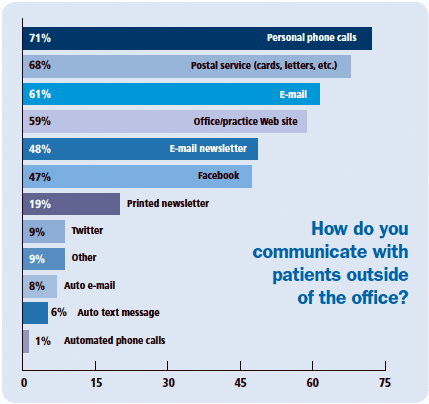 |
|
| ||||||||
|
|
|
August, 2011 Going the Extra Mile: Communicating With Patients Outside the OfficeBy Donald M. Petersen Jr., BS, HCD(hc), FICC(h), Publisher Communication is critical in any relationship; that includes the relationship between doctor and patient. According to a recent survey, only approximately 76 percent of doctors of chiropractic communicate with their patients outside the clinic, even though 94 percent of DCs know it is either very (57 percent) or somewhat (37 percent) important. In short, while most know communication is king, finding the best way to communicate can be a challenge. When asked about the best method to communicate, one doctor stated, "If I knew, I might do it." Caroline Bartley, DC, of Colorado, stated that she is "using a combination of Web site / Facebook / Postal / E-mail." A DC from Vermont noted that "it depends upon the patients' contact preferences; most like to be contacted by e-mail rather than the phone, but they ultimately decide." Another DC from Arizona said, "I am just exploring the means to do it more automatically from the current software." Interestingly enough, personal phone calls are still the most popular way to reach patients outside the office. About half of DCs surveyed said they contact patients for birthdays and holiday, while 40 percent said they send electronic newsletters, the optimal interval being once a month. Electronic health record (EHR) software is currently utilized by a mere 7 percent of doctors to communicate with their patients outside of the office.

Why Bother? Presence There are a number of reasons to communicate with your patients between visits. As Jared Thomas, DC, of California put it, "If you build a strong relationship with your patients outside of the office, they will always be loyal and refer." Dr. Nick Payne of Kentucky agreed, noting that "engaging patients outside the office is a great way to continue the education process and help to retain patients through their course of treatment and into the maintenance phase." E-mail newsletters and Web sites can provide information that teaches wellness lifestyles, said Minnesota chiropractor Karl Weimer: "Health and wellness is a 24/7 lifestyle. People have many choices regarding their health care. A sound evidence-based message can help with being competitive [and provide information to] people to improve their healthy lifestyle." Janelle Hutti, DC, of Tennessee concurred: "In one word: mothers! (i.e. wives, women) are in charge and they are on the Web looking for info. You want to be the person they go to for a question, and they want access to you!" George Simmons, DC, of New Mexico, sees his office as a patient resource: "There is tremendous information available to our patients. The information is often confusing, market-driven or politically-driven. We want to keep at the top of their minds that we are a valuable resource for health information and health services and can direct them to reliable health information and healthy choices." In the end, it is all about maintaining a presence, said Lex Rathbun, DC, of Guam: "In today's busy world, non-aggressive means of maintaining a presence in your patient's mind is integral to a practice, especially on an island with a deep sense of community."
|
Chiropractic Events
|
||||
|
|
|||||